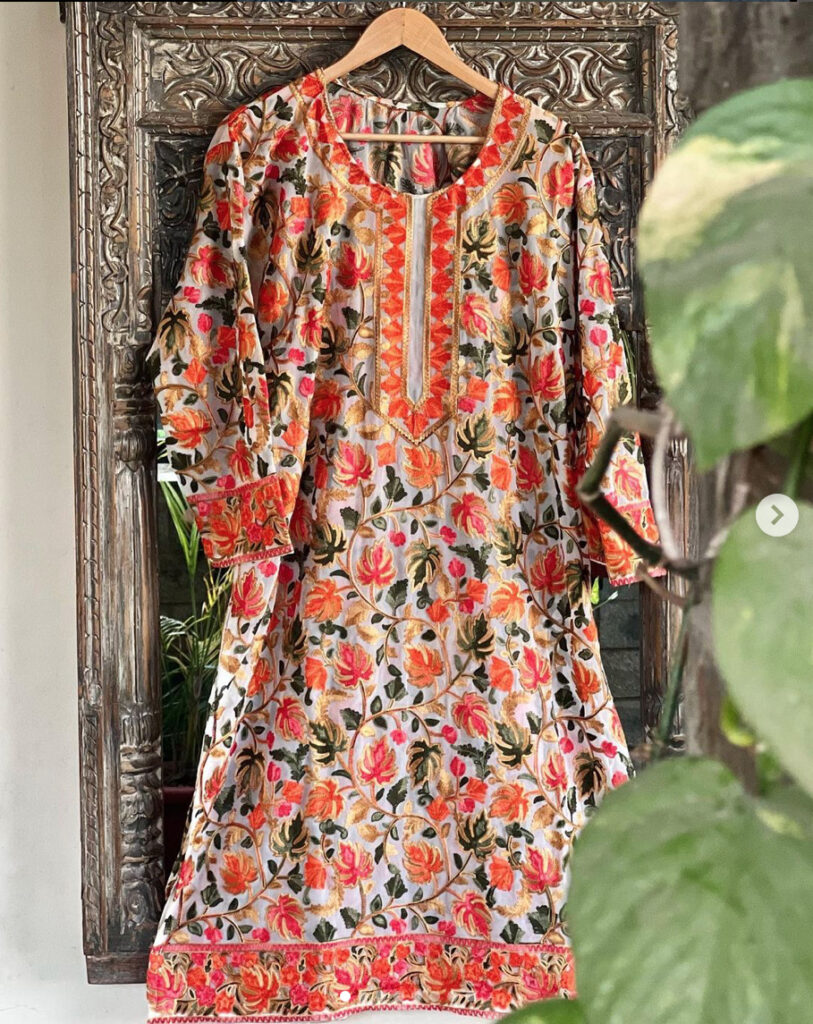Location: Punjab region
Phulkari, made up of two Punjabi words ‘phul’ meaning flower and ‘kari’ meaning work, translates to flower work or floral work. It is a unique technique of embroidery usually spun on charkhas, and is common to shawls and odhanis/odhnis (headscarves). Dating back to the 15th century, the tradition of handmade phulkari embroidery is mostly practised by women in rural areas, as a celebration of womanhood.
Legend:
More than just a craft, phulkari embroidery is said to be an inherent part of the history of Punjab. The first mentions of phulkari were found in the Punjabi text, ‘Heer-Ranjha’. Some scholars believe the art of phulkari came from Iran, where it is called Gulkari (gul being Persian for flower), whereas others argue it was brought to India, from Central Asia, by migrant Jat tribes. In the early 19th century, phulkari-embroidered garments were considered a sign of a woman’s material wealth, and acted as an heirloom that was passed on for generations. Interestingly, in olden times, women would embroider phulkari when a girl child was born, to signify happiness, and that would later be given to the daughter during her wedding.
Today, phulkari continues to play a significant role in Punjabi culture, and is an important part of weddings, especially of a bride’s trousseau. For centuries, the womenfolk have carried a bagh (a shawl completely covered in phulkari embroidery, with not an inch of the original cloth left visible) over the bride’s head, to express solidarity with her. Till date, around 52 categories of phulkari embroidery have been recorded.

Fabric/Materials:
Traditionally, an untwisted floss silk yarn called ‘pat’ is used for phulkari embroidery, while handspun, locally-woven and dyed khaddar (or khadi) forms the base. Now, however, fabrics like crepe, chiffon and even Kota doria (can be customised on other materials too) have gained popularity. Through the centuries, women have embroidered the phulkaris with their hands but, of late, with rising commercial demands, machines as well as modern techniques and materials are coming into play.
Design:
Baghs (all-over phulkari-embroidered cloth) and Darshan Dwars (architectural motifs, mostly presented at gurudwaras) are the most popular. Motifs are either crafted from imagination or borrowed from the immediate environment. Common ones include belan (rolling pin), kakri (cucumber) and chandrama (moon).

With phulkari embroidery emerging as a community activity for women, it also became an expression of their feelings, hopes and dreams, iterated mostly through colours. The phulkari embroidery has traditionally been done, with the needle’s tip pointed away from the embroiderer, indicating that the work has to come from the heart and go towards others. The darning stitch is the most common embroidery technique used to make phulkari. The quality of the phulkari is measured by the width of the stitch—the narrower the stitch, the finer the piece. The patterns are neither drawn nor traced, but embroidered directly onto the cloth. The colours and the motifs, each, have their own significance. For example, red phulkari is preferred for a young bride whereas blue and black are mostly for daily use.

Buyer’s guide:
Phulkari embroidery was awarded a Geographical Indication (GI) status in 2011, meaning only registered manufacturers from the states of Punjab, Haryana and Rajasthan can use this term for the traditional craft. As mentioned above, with the advent of technology, machine-made phulkari has emerged more common and popular, since it’s easier on the pocket. A handmade phulkari embroidery dupatta can start anywhere from 2500 rupees and can keep going up in price depending on the fabric and the intricacy of the work. But the true value of phulkari embroidery, of course, lies in the handmade ones that have unknown tales to tell.
Fortunately, it’s easy to spot handmade Phulkari from machine-made ones:
- As the machine phulkari embroidery is faster, it is going to be more perfect, whereas phulkari made by hand is bound to have some imperfections.
- Look at the backside. The reverse of handmade phulkari embroidery will have stitches, knots or threads pulling out of a few places, whereas the back of machinemade phulkari will be smooth.
- The thread for machinemade phulkari embroidery will be thinner and finer than the one used in handmade phulkari.
- Another tell-tale, of machine-made phulkari embroidery, is trace marks around the edges.

How to care:
Delicate hand wash, in cold water. Iron on the reverse side. Getting your precious phulkari embroidery dry-cleaned, occasionally, will keep the fabric bright and lively.






